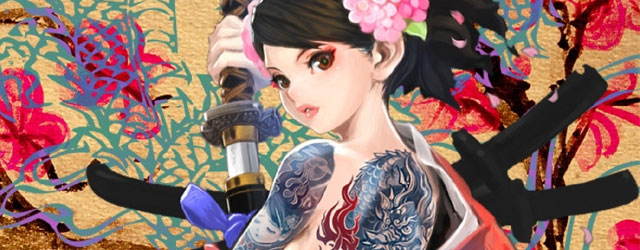[tab:Review]
If the name Vanillaware strikes a smile on your face, then you know about their legacy. This company has been crafting some of the most gorgeous and unique titles for a while now, and their latest might just be their prettiest. Muramasa first saw its light of day on the Nintendo Wii, and while the gorgeous animation and captivating art style looked fantastic; it came at a time when HD was on the rise. The thought of seeing this beautifully animated title in full high-definition glory has always been a dream of mine. Now, that dream has come true.
Muramasa Rebirth for the PS Vita is not exactly what people might call and HD remake, but the title fits for better or worse. This newly enhanced version brightens up the Vita’s gorgeous OLED screen like no other title on the handheld. Animations pop out and the sheer visual fidelity is enough to make passersby stop and take notice. If Sony wants to sell this machine, this is the game to showcase.
For anyone who played the original Muramasa, this remake is more or less the same experience. The obvious differences here are sharper visuals, a better translation of the story and better button mapping. Moving from the Wii remote to a standard control scheme makes a huge difference. Combos are easier to achieve, though I wish they would have mapped the dodge to the right stick. Having to duck before performing it feels unnecessarily complicated.
There are two characters to play as, and unlike some other action titles, each one has their own unique campaign and story beats. While the path they take consists of the same environments and such, the story told is significantly different. They will both encounter unique characters and twists that make playing through the game twice less of a chore.
The story is told through solid voice acting, albeit all in Japanese. There is no option for an English dub, which is fine. As engaging as the story is, it still takes a backseat to the intense sword combat. Muramasa is much like any other Metroidvania-style game with its backtracking and map traversal. I was constantly going back and forth between areas to progress the narrative. Sadly, there is no reliable fast-travel mechanic that makes these treks any less repetitive.
The combat is deeper than what it initially appears. Swapping swords on the fly is imperative in order to keep blades from breaking. Swords also come with a host of enhancements that work well against specific characters. Crafting swords is where the meat of it comes into play. Each character can obtain items to craft new blades, as well as earn some along the way. I could only equip three at a time, and switching them out usually yielded interesting results. It almost becomes overbearing at times, but the experimentation pays off, especially on Chaos difficulty.
This is a point of contention for me. There are only two difficulty settings, and they consist of super easy, and truly challenging. Legend mode provides little challenge, and I only recommend it if the sole purpose of a play through is to see the story, or enjoy the visuals. Chaos mode comes in at full force though. Enemies require strategy and learning blade techniques constantly. The challenge is appreciated, but I wish there had been a better middle ground for those looking for a decent amount of resistance.
If this is my biggest gripe though, Muramasa has little to worry about. For those that own a Vita I suggest picking up Vanillaware’s entry on the machine. It is gorgeous, with stylistic and deep combat, and just plain enjoyable. Anyone clamoring for more software on Sony’s portable should look no further. If we continue to get more games like Muramasa, there may be justification for the Vita’s hefty price tag yet.
Review copy of game provided by publisher.
[tab:Screenshots]
[tab:END]


Kazriko Redclaw
There’s a third difficulty level once you finish the game once. Fury. The Chaos level is actually the “normal” difficulty. ;)
I played the first 2 endings on Chaos, then the game just got way too hard. Some of the caves of evil are downright devious even on Legend.
Backtracking can be minimized by using a Bronze Mirror after every boss. Also, after getting the first 2 endings, you can teleport from shrine to shrine instantly.
You’re right about using this to sell the system. I showed it to a co-worker and now he wants a Vita too.
Gabriel
Vanillaware is known to develop great games filled with art. George Kamitani is a great designer and director, and everything his company creates is a must buy for me. I’d die of happiness if an Odin Sphere’s port came out on Vita.